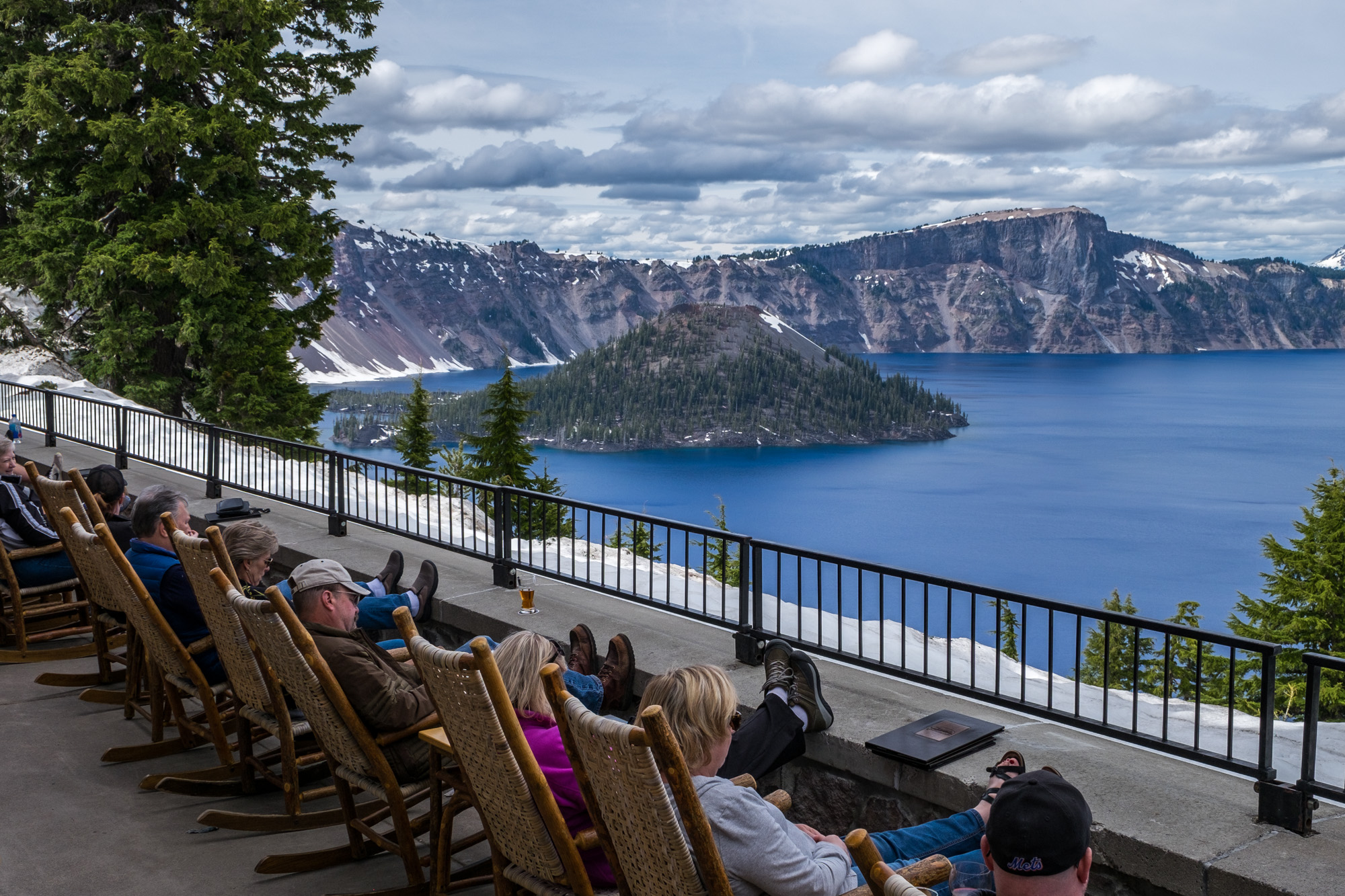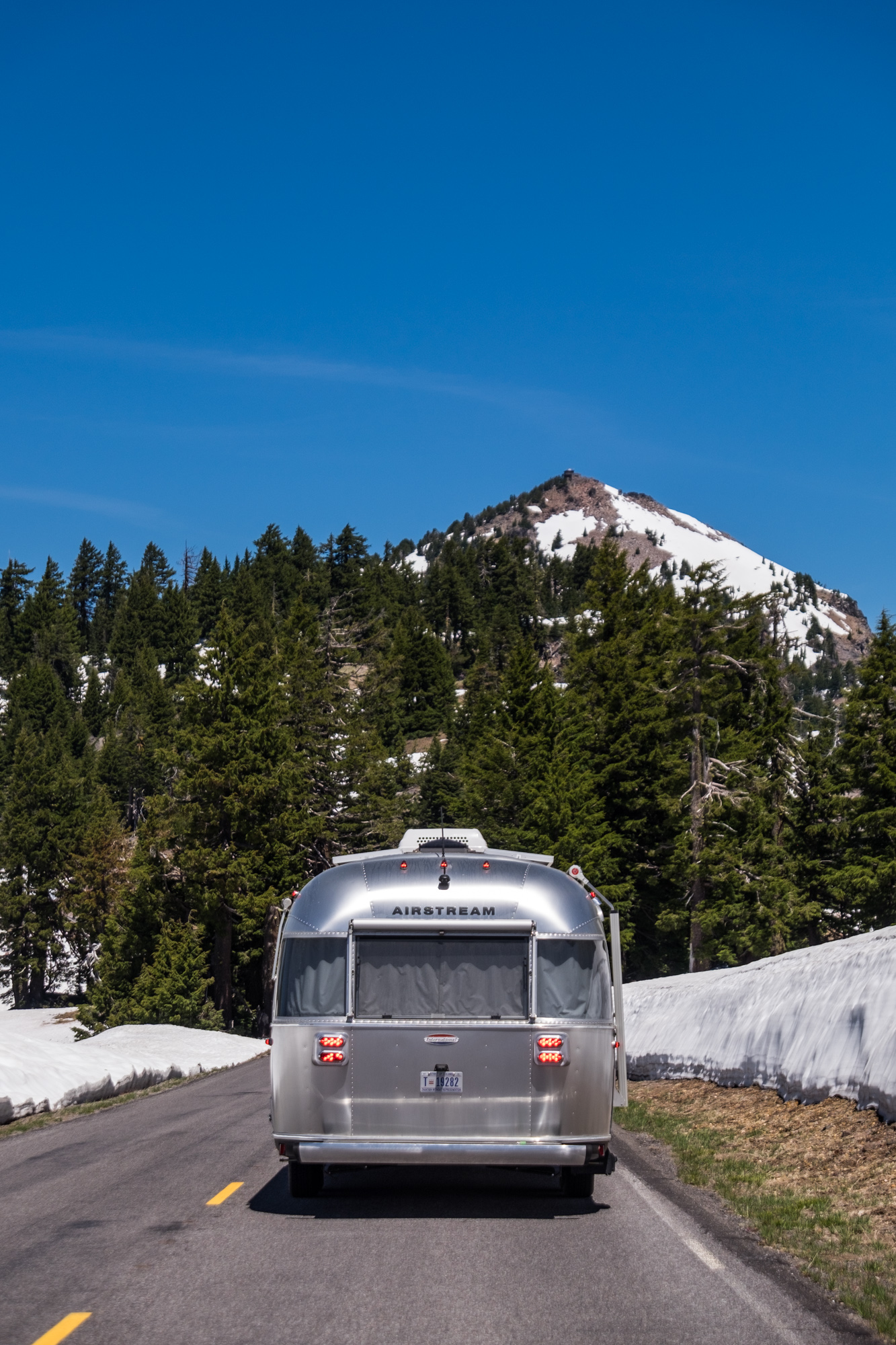Crater Lake National Park, Oregon, USA | Park 26/59
“A lake is a landscape’s most beautiful and expressive feature. It is Earth’s eye; looking into which the beholder measures the depth of his own nature.”
“Crater Lake must be seen to be appreciated properly. Photographs simply cannot depict the majesty of the lake in its setting, the depth of the blue.”
Lodge by The Lake: Crater Lake National Park
Wizard Island rises from Crater Lake in the national park in southern Oregon.
Typically, our park write-ups are mostly focused on the natural area that inspired the protected parkland to be established in the first place. We wanted to switch it up for this one. Every now and again this year we've been struck by stunning features within our national parks built by craftsman to help enhance visitor appreciation... we’re talking about elegant carriage roads made of stone, park entrances carved from tall wooden tree logs, bridges constructed with rocks from mountain river bottoms, and most notably, national park lodges.
A select few of such historic lodges retain the old-time feeling that existed during the days of John Muir and Teddy Roosevelt (his legislation established Crater Lake.) Built in 1915, the Crater Lake Lodge is one hundred and one – one year older than the National Park Service – and it set the standard early on for what all future park lodges should strive to uphold in terms of character. Glimpse for a moment in your imagination what you think a park lodge experience might have looked like at the turn of the 20th century when Crater Lake National Park (the 5th park) was formed – whatever is in your mind, that’s this place! Well-to-do men and women wanting an adventure and also wanting to stay cozy by a fire with drink in hand…it’s pretty much the same today, just add neoprene zip-ups and iThings tethered to the hand. Times have changed, as have the souls, but it’s basically the same deal: accommodations that bring the outside in – the quintessence of a national park lodge.
The Great Hall at the Crater Lake Lodge. Crater Lake National Park, Oregon.
The entrance pretty well takes your breath away with indigenous trees rising from the floor and rising through the roof of the lobby. In the next room, the Great Hall, a massive stone fireplace crackles warmth into the cozy parlor with sitting areas grouped together as though people are meant to sit together and – gasp – converse. Aside all of that, it is the kind of place that you want to wrap up in a cozy sweater and read a book, play a game, or edit and create National Park content while drinking Oregon wine and craft beer. Good luck wanting to leave, right? Not after you get a load of the lodge’s most impressive feature, the outside deck off of the Great Hall, where rocking chairs overlook the 7-700-year-old collapsed volcano turned lake (called a caldera) holding 4.6 trillion gallons of water. It is extremely still and reflective and impossibly blue.
The patio at the Crater Lake Lodge overlooking the gem of the park.
To walk onto the back patio for the first time is sublime. Almost even more wonderful is hearing others’ reactions when they walk out for the first time – the oohs and aahs and “oh my Gods!” – it is one of the finest views anywhere in the world and to be able to see it just steps from your room is simply amazing in this day and age.
The peak season for this park is summer (June-October) when you can get onto the lake, explore areas with lake access, drive the full length of Rim Drive, and hike out on passes that aren’t rendered impassable by slushy melting snow. Even during the summer season you might meet up with some snow as a result of the high altitude (6,178 feet.) During the winter, exploring the area by snow machine, on skis, or on a secluded backcountry hike is pretty much the only way to get into the park and we can only imagine how breathtaking it would be in such a silent state. Regardless of when you plan to visit, look thoughtfully at the official Crater Lake National Park website prior to planning so that you know what areas will be open and ready to greet you upon arrival. Happy trails!
26 parks down, 33 to go!
Quotable Images
Fact Box
183,224 acres | Home to the deepest lake in the U.S. | America's 5th National Park
Park name: Crater Lake National Park
Established: May 22, 1902
Location: Southern Oregon
How the park got its name: When the first non-native explorers discovered the area in 1853, they called it Deep Blue Lake (we are seeing a lot of this literal naming convention in and around historic areas this year.) Legend goes that it was modified to Crater Lake in 1869 by a journalist who was describing cinder cone atop Wizard Island as a crater in the Oregon Sentinel newspaper.
Iconic site in the park: There is arguably no better view of the Crater Lake caldera than from the back deck of the Crater Lake Lodge, where rocking chairs line a patio overlooking a view that is just as beautiful to see as it is to photograph, at both sunrise and sunset. Along with the view, visitors drink in a cocoa or a classic cocktail with patio service from the adjoining lodge restaurant.
Accessible adventure: Auto tour the Rim Drive and its surrounding landscape along 33 miles of winding paved road. That a road of any kind even exists on the rim of a caldera is remarkable, and that is why the drive is commemorated as a Historic District on the National Registrar of Historic Places. Start at the main visitor center area and finish in Munson Valley, stopping at the most prized lookout spots in the park along the way (eyes akimbo, you really can't miss them.) It isn’t by chance that amazing views line the road – this engineering fete was built with exactly that purpose in mind.
Big adventure: Ride the rim of Crater Lake by bicycle! Twice a year in the late summer, East Rim Drive is closed to vehicular traffic, making a safe space for cyclists to ride 25 miles with a 3,500-feet elevation gain along one of the great wonders of our world. There are rest stops and side attractions for friends and family cheering but not riding that day, and registration is free.
Nature's Rorschach test -- reflection perfection at the deepest lake in the United States.
Did you know…
Crater Lake is known for its perfect reflection, a product of its depth, absence of silt, and also of streams flowing out to the sea. Water level is maintained by precipitation and snowmelt.
Crater Lake is the deepest lake in the United States, the second deepest in the Western Hemisphere, and the seventh deepest in the world. It contains 4.6 trillion gallons of water.
The water temperature varies between 38° at depth, and 60° on the surface in the summer. People make a point to jump into the lake, but there are only a couple of areas that it can safely be done. Attempt at your own risk!
The Klamath American Indian tribe believed the lake to be so deeply spiritual that only the wise were able to see it.
Looking for dark sky country? Head to Crater Lake!
Crater Lake is designated by the National Park Service Dark Sky Team as one of the top 10 starriest areas in the park system.
A portion of the famed Pacific Crest Trail runs through Crater Lake National Park.
Rim Drive is the most accessible and popular way to explore the park, and is open for a remarkably short amount of time, just June to October.
There is a pumice desert in the park. It was formed by ash that flew with the eruption of Mount Mazama, the event that created the lake.
Remnants of the record snowfall this winter...in the middle of June.
During the winter 2015/2016 season, there was more snow at Crater Lake than ever before in the history of the National Park (101 years) – measuring 45 feet.
A 30-foot hemlock tree has been bobbing in the lake for over a century. It is called the “Old Man of the Lake.”
The most well-known island in the lake is Wizard Island, a volcano rising up from within the lake, so called for its resemblance of … you guessed it, a wizard!
The last time the lake froze over was in 1949.
Crater Lake National Park has one of the shortest summer seasons of any national park. Located at 6,500’ elevation, snow covers the park for 9 months out of the year, from October to June.























































